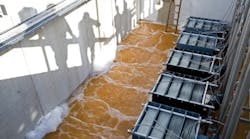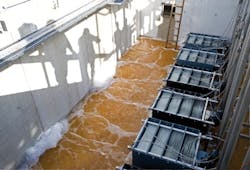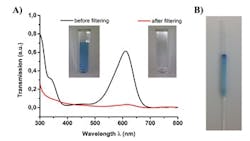The quest to optimize water re-use and anticipate regulatory pressures is driving many plants to give increasing attention to their wastewater. To help meet the challenges, wastewater treatment specialists such as Dow Water & Process Solutions and Microdyn-Nadir are introducing new technologies. Meanwhile, researchers at universities in Germany, Spain and Singapore are working on potential future options, scaling up separation techniques based on ionic solutions and biomimetic membranes.
“As part of Dow’s reduce, reuse and reclaim circular economy approach we are really focused on the finite water supply. So we want to squeeze as much as possible from all the water used by industry, including the chemical industry,” says George Barclay, global R&D director at Dow Water & Process Solutions, Edina, Minn.
[callToAction ]
To do this, the company has developed a broad portfolio of treatment technologies ranging from mechanical filtration for suspended solids, pressurized ultrafiltration (UF) for macromolecules and bacteria, nanofiltration (NF) for separation of mono- and di-valent ions and very small molecules to the more rigorous separations of reverse osmosis (RO) and ion exchange (IX) resins.
“However, there is no one size fits all. You have to design solutions for different wastewaters: different contaminants need different suites of technologies. The challenge for the chemical industry is to increase water recovery and ensure treatment reliability,” he adds.
One way that Dow is helping here is with its minimal liquid discharge approach, which focuses on reducing the cost of brine concentration and maximizing water recovery. This is especially important in China, where much of the chemical industry operates in the more arid north and pressure to use water as sparingly as possible is great. So there, brine concentration before crystallization of the salt commonly relies on mechanical vapor recompression and evaporators.
“The addition of ultra-high-pressure (UHP) RO to the membrane filtration process can reduce the water going to the evaporation step by 50%. So that saves on energy use and we can squeeze another 5% of water out of the process,” explains Barclay.
Figure 1. New unit uses laminate membrane to overcome traditional problems with clogging and membrane fiber permeability Source: Microdyn-Nadir.
Another example is a new UF module for particle removal (IntegraFlux SFP-2880XP) that is based on novel hollow-fiber technology made by a diffusion-induced phase separation process. That process enables accurately controlling the pore structure of the fiber down to 30 nm, allowing for consistent removal of bacteria, viruses and turbidity. Moreover, increased flux, achieved by modifying the internal structures of the fibers, decreases pressure and associated energy costs.
To cut water hardness and chemical oxygen demand (COD), plants typically turn to IX resins. Here, Dow has used new monomers to develop a resin (Amberlite IRC) that it says has both a higher throughput (48%) and greater stability than existing IX options. “As a result, there are fewer regeneration cycles, which saves energy and reduces chemical use, plus you can handle tougher waters,” notes Barclay.
The company also offers new ion separation membranes (Filmtec Fortilife XC-N) for NF. These convert a large fraction of RO concentrate waste into purified salt solutions that are easier to crystallize or re-use. The membranes reportedly boast high permeability and ion selectivity; they provide high sodium chloride passage and very high di-valents and COD rejection. The salt then can be re-used.
To illustrate this in action, Barclay cites a chemical plant in China that produces ferric sulfate as a raw material for the lithium ion battery industry. The production process generates a large amount of low pH wastewater containing high concentrations of both ammonium nitrate and ammonium sulfate — neither of which are allowed to be discharged. “Here we have developed an innovative process based on RO technologies, including UHP RO, to reclaim and concentrate the ammonium compounds from production wastewater as valuable chemical fertilizer, and simultaneously re-use the purified water as process water.”
The company is working on new robust membrane chemistries that will work in harsh environments, for example in very low and high pH and in the presence of organic solvents. This, notes Barclay, will allow the chemical industry to separate and recover additional materials from its wastewater streams.
Dow also is developing a number of new but unspecified technologies at the molecular separation end. Plus, it has filled a missing element in its portfolio — secondary biological wastewater treatment (biodegradation) — with an investment in Oxymem, Dublin, Ireland. That company uses novel membrane aerated biofilm reactor (MABR) technology that is said to reduce energy consumption by 60–70%.
In addition, this fall Dow plans to launch software that will ease choosing the most appropriate treatment technologies. “At the moment, there are multiple software options for modeling each component, for example IX, UF, RO, NF, etc. For the first time, we have combined them all in one solution. So the company inputs what its water stream contains and then selects what they want to achieve. The software gives the best technologies and processes for achieving this. It’s been beta tested by 300 companies with very positive results,” Barclay says.
Combining Technologies
Meanwhile, the latest result of the 14-yr relationship between Microdyn-Nadir, Wiesbaden, Germany, and Huber, Berching, Germany, is a new membrane bioreactor (MBR) that the companies hail as groundbreaking — claiming it offers lower operating and investment costs as well as an increase in reliability and packing density. It integrates Microdyn-Nadir’s new Bio-Cel laminate membrane technology with Huber’s existing VRM rotating-membrane treatment system.
The VRM system mounts trapezoidal membrane segments onto air tubes, submerges them in activated sludge, and rotates them through an air induced flushing stream driven by a filter drive. The Bio-Cel laminate replaces the usual flat-sheet membranes. Bio-Cel is a hollow sheet (Figure 1), not a traditional hollow fiber or a plate. It is backwashable like a hollow fiber module. Problems such as fiber clogging can’t occur, say the companies. A novel mechanical cleaning process reduces cost, obviates the need for downtime for intensive cleaning, and keeps the fiber permeability stable, they add.
Another development is a self-healing mechanism. “This is our unique selling proposition and a big differentiator as our laminate technology allows a damaged membrane to sustain effluent quality,” notes Julian Klein, Microdyn-Nadir product manager.
The company is conducting trials of its new MBR technology at a pilot wastewater-treatment plant in Huenxe, Germany. That installation targets micropollutant removal, specifically microplastics and multi-resistant germs.
“The most common way to eliminate micropollutant contaminants today is to add activated carbon to the clarified water and then filter using a sand filter. But the sand filter doesn’t reject microplastics and multi-resistant germs,” Klein explains. “In this trial, we are using activated carbon and two 25-m2 laminate membranes in each of two modules. The laminate is made of polyethersulfone with a pore size of 0.04 µm. Six months in and the results are very promising.”
The project currently is undergoing careful evaluation to determine the size and scale of the next trial phase, he adds.
Microdyn-Nadir also is running an MBR trial with water treatment company Ovivo, Austin, Texas. This focuses on municipal wastewater treatment. “They have used other MBR technology in the past, but ours has a smaller footprint and less energy demand,” Klein says.
Those two benefits will be very important in the future as MBR systems further optimize aeration technologies and so further reduce energy use and therefore cost, he believes: “MBR systems are much more space-efficient than conventional treatment plants, which is especially important for chemical applications as they require a compact design.”
Figure 2. POM-SILP filter technology removes inorganic, organic, radioactive, and microbial impurities from water. Source: Institute of Inorganic Chemistry, Ulm University.
In the next five-to-ten years, he foresees much tighter restrictions on wastewater treatment. He expects this to lead to direct treatment of wastewater by MBRs, replacing existing methods such as ultraviolet and ozone — a development that would involve totally different membrane modules from those available today.
Like Dow, Microdyn-Nadir is keen to become a one-stop shop for all membrane filtration products, and last September bought specialty membrane company Trisep, Goleta, Calif. Trisep long has focused on RO and NF technologies, particularly for niche applications.
Customizable Composites
Meanwhile, researchers at the universities of Ulm, Germany, and Zaragoza, Spain, are pushing ahead with the development of supported ionic liquid phase (SILP) materials based on polyoxometallates (POMs). These novel multifunctional composite materials remove inorganic, organic, radioactive and microbial impurities from water (Figure 2).
POMs are clusters of oxygen atoms joined to transition metals in a 3D network. Using polyoxotungstate anions that bind heavy metals and antimicrobial tetraalkylammonium cations, a team from the two universities has developed ionic liquids that are hydrophobic, immiscible with water and that form stable thin layers on POM surfaces.
The researchers hope their new POM-SILP filter materials will form the basis for the development of contaminant-specific chemically designed filter systems that can be used for the reliable purification of water, notably after chemical accidents and natural disasters.
“POMs have the advantage that we can tailor them on the molecular level for specific needs, i.e., we can design the number and size of metal binding sites and tune the POMs, e.g., for binding of heavy metals or nuclear waste products like uranium or thorium/plutonium. Other options are also possible,” explains Carsten Streb of the Institute of Inorganic Chemistry, Ulm University.
“The tuning is possible by chemical modification of each component. The nice thing is that we can independently tune cation and anion and thereby introduce two functionalities at the same time. We use this, for example, to optimize the SILPs for different types of microbes, different types of toxic heavy metals and also for the binding of persistent pharmaceuticals which are more and more found in drinking water in the developed world,” he adds.
As well as addressing several typical contaminants at once, the system reportedly requires no infrastructure and no expert knowledge to install — keeping costs low compared to other technologies.
“The big benefits I see for the system are in terms of decentralized water supply and emergency situations, for example after chemical spillages or environmental catastrophes.
Streb’s team currently is looking to scale up to a pilot test that can handle several liters of water; they also are discussing with a water filter manufacturer about conducting a joint study.
Biometric Membrane
Meanwhile, researchers in the department of chemical and biomolecular engineering at the National University of Singapore are succeeding in improving the performance of their biomimetic membrane technology, details of which first emerged early in 2016 (“Biomimetic Membranes Show Promise”).
The membrane uses the same water channels, known as aquaporins, that are found in almost all living things from bacteria to kidneys. Aquaporins are membrane proteins that selectively conduct water molecules into and out of cells, preventing the passage of ions and other solutes.
The aquaporins are placed onto polymer membranes to act as channels, allowing only water to go through — very quickly, at low pressures and with a low energy requirement.
“We have further refined the biomimetic membrane and enhanced its performance since. We have improved the membrane permeability — in terms of pure water flux, it is now up to four times higher than the current commercial standard,” notes principal investigator Tong Yen Wah.
“Using a two-pass system, we have also successfully increased the membrane’s overall salt rejection from 61% for sodium chloride and 75% for magnesium chloride initially to 95% now for both — which matches industry requirements,” he adds.
While other biomimetic membranes tend to be quite fragile, the researchers note, their membrane exhibits high mechanical strength and stability during the water filtration process. This strength suits the membrane for industrial applications in water treatment, as well as for potentially providing drinking water to the public at lower cost — up to 30% lower, they believe.
Tong confirms the researchers remain in ongoing discussions with a U.S.-based company to develop a pilot-scale module that will test the feasibility of the membranes over the next two years. “The team is committed to furthering this research,” he adds.





